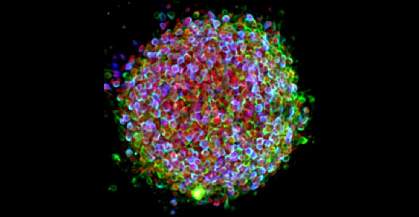You are here
July 16, 2012
Skin Cells Yield Clues to Parkinson’s Disease

Scientists were able to gain new insights into Parkinson’s disease by reprogramming skin cells from patients into neurons. The technology can help researchers understand how the disease develops and which drug treatments might be effective for which patients.
Parkinson's disease is a neurologic disorder that destroys neurons in the brain. Loss of these neurons leads to involuntary shaking, slowed movements, muscle stiffness and other symptoms. Medications can help manage the symptoms, but there's no treatment to slow or stop the disease.
Most cases of Parkinson's disease are sporadic, meaning that the cause is unknown. However, many genetic regions have been found to harbor variations that affect the risk of developing the disease. Researchers have also identified mutations in 9 genes that can cause Parkinson's disease.
A research team led by Dr. Ole Isacson of McLean Hospital and Harvard Medical School set out to use stem cell technology to gain new insights. They collected skin cells from 5 patients with genetically inherited forms of Parkinson's. Three of the patients had mutations in a gene called LRRK2. Two others were siblings who had mutations in the gene PINK1. The scientists also collected cells from 2 of the siblings' family members who didn’t have Parkinson's or any known mutations linked to it. The study was funded primarily by NIH's National Institute of Neurological Disorders and Stroke (NINDS). It appeared on July 4, 2012, in Science Translational Medicine.
The scientists first reprogrammed the skin cells into embryonic-like stem cells called induced pluripotent stem cells. These have the ability to turn into almost any type of cell in the body. Next, they coaxed the cells into becoming neurons, including the type that die in Parkinson's disease.
Studies have suggested that problems in mitochondria, organelles that use oxygen to extract energy from glucose, may underlie Parkinson's disease. The researchers thus looked for signs of impaired mitochondria in the neurons. They found that oxygen consumption rates were lower in cells with LRRK2 mutations and higher in cells with the PINK1 mutation. PINK1 mutant cells were also more vulnerable to oxidative stress, a damaging process that could potentially be counteracted with antioxidants.
The researchers exposed the cells to mitochondrial toxins and found that, compared to neurons from healthy people, the patient-derived neurons were more likely to become damaged or die. The team next used the cells to test drug treatments that have shown promise in animal models of Parkinson's. All the neurons were partly protected from toxin damage by the antioxidant coenzyme Q10. The immunosuppressant rapamycin helped prevent damage to neurons with LRRK2 mutations but didn't protect those with PINK1 mutations.
“These findings suggest new opportunities for clinical trials of Parkinson’s disease, in which cell reprogramming technology could be used to identify the patients most likely to respond to a particular intervention,” says Dr. Margaret Sutherland, a NINDS program director. The technology might also help identify the most promising treatments for people with sporadic Parkinson's disease.
Because of their potential, the cell lines developed for this study are being made available to researchers through an NIH-funded cell line repository. Similar reprogrammed cells have also recently shown promise for exploring other disorders, such as Huntington's disease.
Related Links
- Parkinson's Disease
- Study Reveals Parkinson’s Disease Risk Genes
- Induced Pluripotent Stem Cells Give Investigators a New Window into Neurological Disease
- Stem Cell Basics
References: Sci Transl Med. 2012 Jul 4;4(141):141ra90. PMID: 22764206
